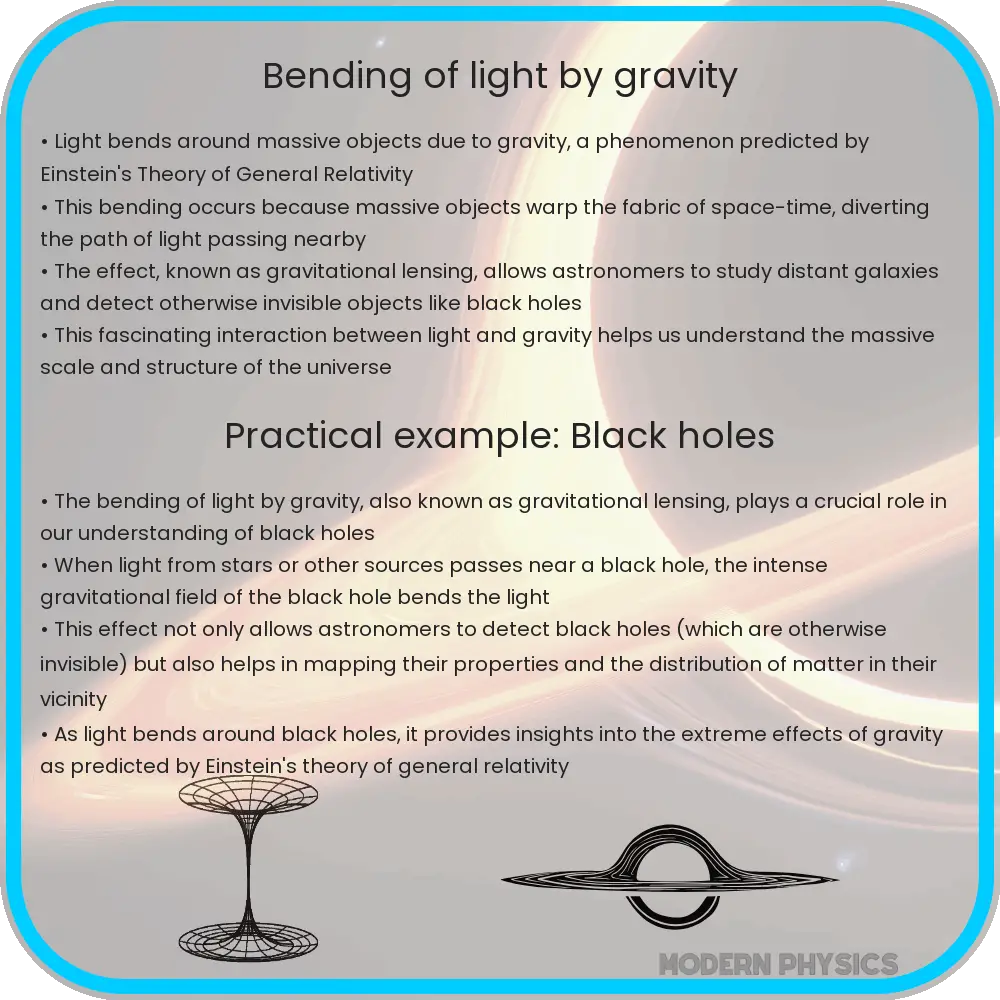Learn how gravity bends light, a key concept of Einstein’s general relativity, impacting our understanding of spacetime and celestial phenomena.

The Phenomenon of Light Bending by Gravity
One of the most fascinating predictions of Albert Einstein’s theory of general relativity is the bending of light by gravity. This concept not only redefined our understanding of light but also significantly altered the way we perceive gravity and spacetime. In simplest terms, general relativity suggests that massive objects can warp the fabric of spacetime around them, and this curvature affects the path that light takes as it travels through space.
Understanding General Relativity and Spacetime
Before delving deeper into how light bends, it’s crucial to understand the foundational principles of general relativity. Proposed by Einstein in 1915, this theory extends the earlier special relativity, which applies to non-accelerating frames, to include gravity as a depiction of the curvature of spacetime. According to this theory, what we perceive as the force of gravity actually arises from the bending of the four-dimensional fabric of spacetime by mass and energy.
The standard analogy is to imagine a stretched rubber sheet. If a heavy object like a bowling ball is placed on the sheet, it creates a depression or curve. A smaller ball rolled near the bowling ball would spiral inward towards it, not because there is a direct force between the two balls, but because the path it travels is curved by the indentation.
How Light Bends Around Massive Objects
In a similar vein, when light passes near a massive object, such as a star or black hole, the intense gravitational field of these bodies curves the spacetime and modifies the light’s path. This effect was first observed during a solar eclipse in 1919, an expedition led by Sir Arthur Eddington. By measuring the position of stars near the Sun during the eclipse, Eddington showed that their apparent position was slightly shifted due to the bending of light by the Sun’s gravity.
The bending of light by gravity can be described by the equation:
\[ \theta = \frac{4GM}{rc^2} \]
where:
- \(\theta\) is the angle of deflection,
- G is the gravitational constant,
- M is the mass of the object creating the gravitational field,
- r is the closest distance of the light to the mass,
- c is the speed of light in vacuum.
This formula shows that the bend is proportional to the mass of the object and inversely proportional to both the closest distance and the square of the speed of light.
Real-World Effects and Phenomena Influenced by Light Bending
The bending of light by gravity has several practical and observable implications in astronomy and astrophysics. One such phenomenon is gravitational lensing, where light from a distant star or galaxy is bent around a closer massive object, forming what appears from Earth as a ring, known as an “Einstein ring. This effect not only confirms general relativity but also helps astronomers study objects that are otherwise too dim or too far to be seen.
Additionally, bending of light affects the measurement of the position and distances of celestial bodies. It’s crucial for accurate GPS satellite operation, astrometry, and in long-range space navigation, where prediction and compensation for these shifts are vital for precise calculations.
The theoretical groundwork laid by light bending also plays a role in concepts like black holes and wormholes, pushing the boundaries of our understanding of the universe.
Implications for Technology and Future Explorations
Understanding the bending of light due to gravity extends beyond theoretical physics into practical technological applications. For instance, the principles of light bending are instrumental in the design of gravitational wave detectors such as LIGO (Laser Interferometer Gravitational-Wave Observatory). These detectors have opened new avenues for observing cosmic events like colliding black holes and neutron stars, phenomena that emit gravitational waves predicted by Einstein’s relativity.
Furthermore, future explorations and experiments aim to utilize the phenomenon of light bending in technologies such as deep-space communication. By understanding how light bends around planets and stars, scientists can develop better strategies for sending information across vast distances, potentially reducing communication delays in space missions.
Education and Broader Impacts
The curiosity sparked by the bending of light by gravity also has an educational impact. It not only captivates the interest of budding scientists but also plays an essential role in teaching complex concepts in physics. Demonstrating how general relativity works through practical examples like gravitational lensing makes it amenable to a wider audience, thereby promoting a deeper interest in science and technology.
Moreover, the public’s fascination with phenomena like black holes and the visual representation of these concepts in media help bridge the gap between complex scientific theories and general understanding. This bridge aids in building a scientifically literate society, better equipped to understand and support advancements in technology and physics.
Conclusion
The bending of light by gravity is more than just a captivating prediction of general relativity; it is a fundamental aspect that influences multiple fields of scientific inquiry and practical applications. From enhancing our understanding of the universe through observations of galaxies and black holes to improving navigational systems and future technologies in communication, the impact of this phenomenon is profound and far-reaching.
As technology progresses and our understanding deepens, the bending of light will continue to play a crucial role in both the exploration of cosmic phenomena and in practical applications closer to home, illustrating the elegance and utility of Einstein’s theory in modern science and everyday life.
